Investment Opportunities in Q1 2025: Top 5 Emerging Markets Reshaping the CONMA Domain

The construction and manufacturing domain has experienced significant growth in recent years owing to the rising pace of industrialization and urbanization in developed and developing countries in Asia-Pacific, North America, LAMEA, and Europe. The rising disposable incomes of people in these regions have led to a rise in demand for real estate, automobiles, and other such consumer goods. Along with this, the introduction of advanced technologies such as AI, data analytics, and IoT has created new investment opportunities in the industry. Moreover, the advent of additive manufacturing techniques such as 3D printing has opened new avenues for growth in the sector. Simultaneously, certain markets have made substantial contributions to the expansion of the CONMA domain in the first quarter of 2025. The newsletter covers all the important factors influencing the growth of these emerging markets in Q1 2025 to help companies understand the evolving nature of the landscape.
Axial Piston Hydraulic Motors and Pumps Market
Axial piston hydraulic motors and pumps are some of the most important components of hydraulic systems which convert fluid energy into mechanical power. The efficiency and versatility offered by these machines have increased their utility in different industries such as automotive, industrial equipment manufacturing, and construction tools production. The axial piston hydraulic motors and pumps market accounted for $2.9 billion in 2023 and is anticipated to gather a revenue of $4.7 billion by 2033, rising at a CAGR of 4.8% during 2024-2033. The growing emphasis on reducing energy usage in production processes has led to a rise in the demand for these machines in Q1 2025.
The AMR report classifies the market into various segments based on product type and application. The main motive of this segmental analysis is to aid businesses in making the right investment decisions in the long run. On the basis of product type, the axial piston hydraulic motors segment is anticipated to have the highest CAGR in the near future. The growing use of these components in construction machines such as bulldozers, excavators, and loaders is predicted to augment the growth rate of the segment in the first quarter of 2025.
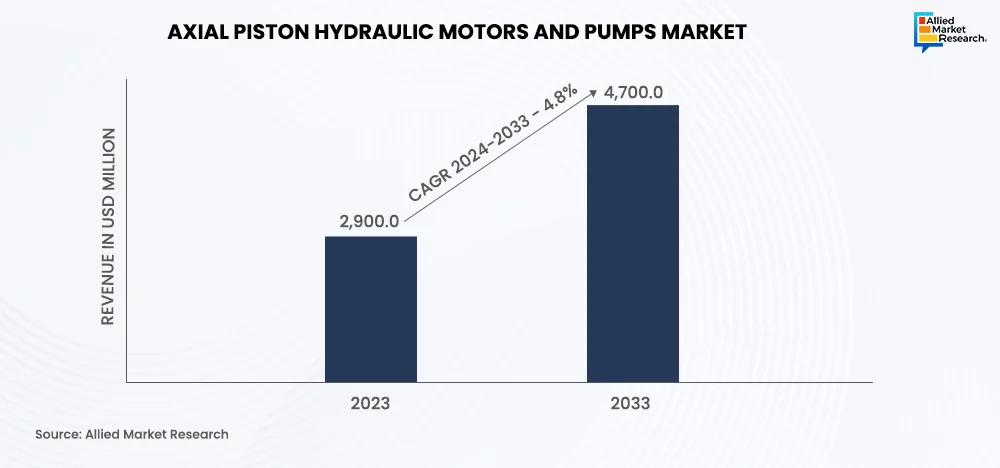
Horizontal Directional Drilling Market
Horizontal directional drilling is an innovative, trenchless construction procedure used to install underground pipes, service conduits, and cables. This methodology has become quite popular in metropolitan cities and industrial towns where multiple roads, railways, buildings, and water bodies create obstacles in trenching processes. The growing need for resilient infrastructure to support smart city initiatives is estimated to help the horizontal directional drilling market gather a sum of $17.6 billion by 2033. The industry accounted for $8.1 billion in 2023 and is predicted to rise at a CAGR of 8.1% during 2024-2033.
The AMR report highlights the performance of the industry in various regions of the world, including Asia-Pacific, North America, LAMEA, and Europe. The rapid pace of urbanization in emerging countries like China, India, Indonesia, Japan, and Singapore is expected to create numerous growth opportunities in the Asia-Pacific horizontal directional drilling industry. Rising investments in infrastructure development, mining, and other construction activities have surged the demand for advanced rock drilling techniques, thus broadening the scope of the market in this region. Apart from this, the launch of 5G technology and the growing adoption of Internet services in various Asia-Pacific nations accelerated sectoral growth in the first quarter of 2025.
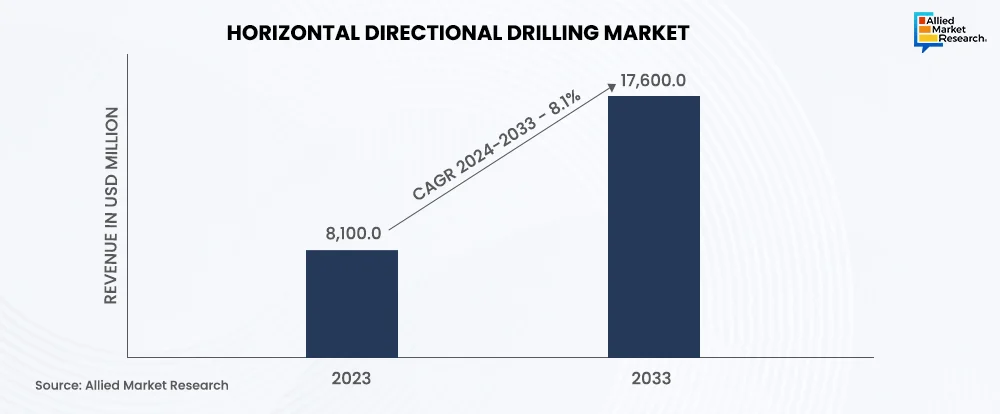
Claddings Market
The cladding market accounted for $248.3 billion in 2023 and is projected to register a revenue of $485.5 billion by 2032, citing a CAGR of 7.4% during 2024-2032. In the last few years, the rising demand for energy-efficient and sustainable building solutions has played an important role in the growth of the industry in the first quarter of 2025. Furthermore, the rising preference for aesthetically pleasing and durable buildings has helped the market flourish. Moreover, technological advancements in material sciences have led to the development of innovative products such as self-cleaning surfaces and lightweight cladding panels, thus contributing to the expansion of the landscape in recent times.
The segmental analysis offered in the AMR report classifies the claddings market on the basis of type, product type, and application. By application, the industrial and commercial segments experienced huge growth in recent times and are predicted to dominate the sector in the coming period. The growing number of retail centers, industrial facilities, and office spaces in urban areas impacted the market positively. On the other hand, the residential segment is expected to have the highest growth rate in the forecast period owing to the rising demand for modern housing.
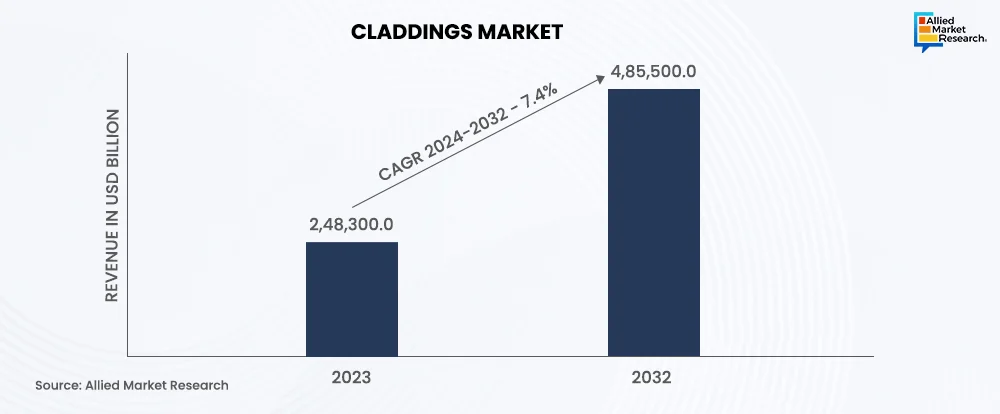
Construction Sustainable Materials Market
In the last few decades, awareness regarding environmental sustainability has grown significantly due to the hazardous effects of global warming and climate change. The construction sector has been heavily criticized owing to its role in increasing pollution levels in different ecosystems, thus posing a threat to global biodiversity. As part of the net zero goals declared by various countries, several governments have launched initiatives and schemes promoting the use of eco-friendly building solutions. This transition is expected to help the construction sustainable materials market to reach $687.8 billion by 2033. The industry accounted for $341.9 billion in 2023, rising at a CAGR of 7.4% during 2024-2033.
The AMR report presents a comprehensive overview of the different socioeconomic, cultural, demographic, administrative, legal, political, and administrative factors impacting the growth of the construction sustainable materials industry in various regions across the globe. As per the study, the Asia-Pacific province is expected to experience huge growth in the near future on account of the recent innovations in biodegradable and recyclable materials.
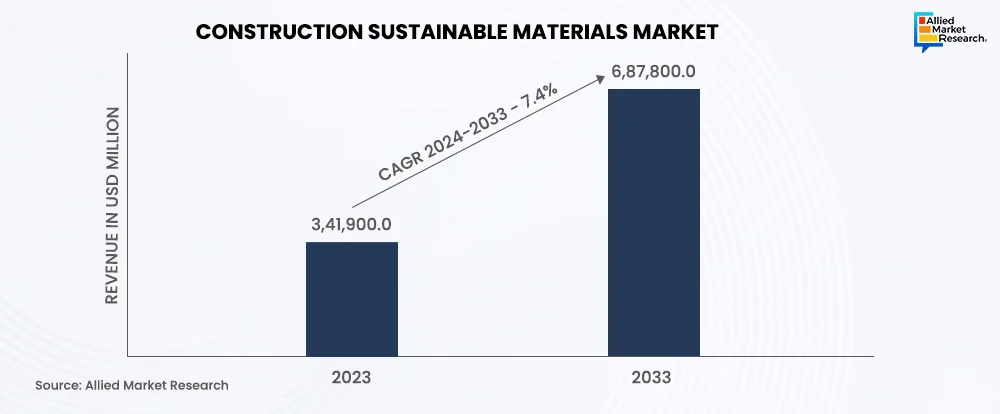
North America Railway Maintenance Machinery Market
The North America railway maintenance machinery market is predicted to gather a revenue of $1,855.7 million by 2034. The industry accounted for $1,145.3 million in 2024 and is estimated to rise at a CAGR of 5.8% during 2025-2034. Railway maintenance machinery includes a set of tools and specialized equipment utilized for the upkeep, repair, maintenance, and enhancement of various railway tracks and other infrastructure facilities. The growing investments by governmental agencies across the globe in railway transportation created favorable conditions for the growth of the industry in the first quarter of 2025.
However, the high initial costs of procuring advanced rail machinery are expected to restrict the growth of the industry. Nonetheless, the advent of smart rail infrastructure generated lucrative opportunities in Q1 2025. The introduction of sensors, automation solutions, and real-time monitoring devices in rail maintenance processes has accelerated the industry’s growth in the past few years and is expected to influence the growth of the market in the coming period.
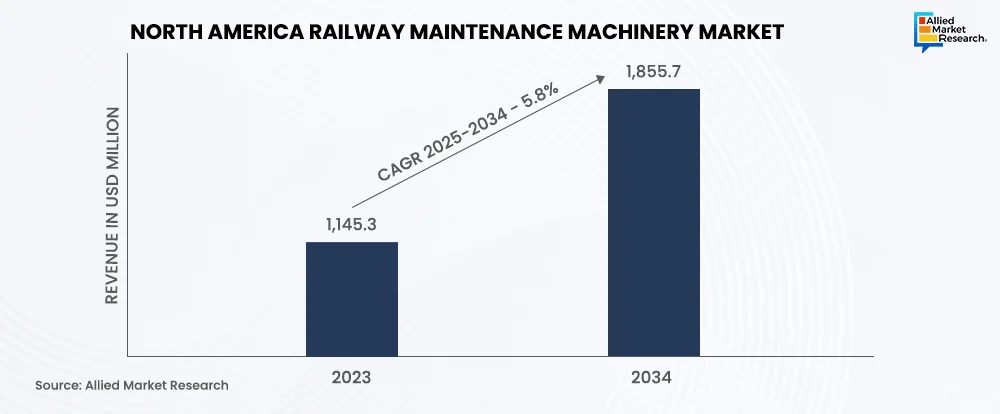
The final word
The rising pace of industrialization and urbanization has revolutionized the construction and manufacturing domain in the post-globalization era. Additionally, the emergence of advanced technologies and the shift toward sustainability have opened new avenues for growth in the industry in the last few years. Moreover, the launch of smart city initiatives across the globe is predicted to augment the growth rate of the sector in the near future. In addition, growing investments by governmental agencies and private companies in infrastructure development and transportation projects brought in numerous opportunities in the domain in Q1 2025.
Reach out to our experts for valuable insights on key growth factors and investment opportunities in the sector!



